Reflections from Cincinnati Delegates Avi Goldstein & Drew Schneider…
Avi:
We boarded the bus this morning and headed towards the petit town of Lublin. Beautiful architecture, pubs, and polish signs lined the streets. It was hard to imagine such a beautiful area as once a harsh Jewish ghetto. We collected in front of an old building that was used as an orphanage for young Jews during the war. My positive view on the town shifted as I learned about the soldiers and trucks that took all the children, infants included, away from their home, out of the town, and into the woods to be massacred. It was hard to imagine the adults at the orphanage forced to watch all the children they lived with murdered before being shot themselves right in the peaceful town we stood in.
The morning set the tone for our next stop, Majdanek concentration camp. We bundled up in our coats, hats, and scarves and entered through a rocky passage that had a huge, intimidating rock awaiting above us at the end of the entrance way. From standing on any path in the camp, the skyline of Lublin is visible. The location of so many atrocities was so close to the town and yet they continued the labor until death process, uninterrupted, for 2.5 years. My stomach turned as we learned the story of Ilse Koch, the German general’s wife, who would ride her horse around the camp and point out individuals with unique tattoos to be killed, skinned, and turned into lamp shades for her home.
Realizing the amount of detail and preparation put into building Majdanek was hard to stomach as well. A company had to design the architecture, the floor plan for gas chambers. Somebody designed a trench around the chamber to collect body liquid. Another created a gas-safe door to seal in the hundreds of victims. Somebody sat down and designed an oven that would be most efficient for burning human bodies. A bathing room was even put into the warm crematorium for the german officers to relax in.
By hour 3 of walking through the bitter cold and heavy winds we all started to feel a bit tired, hungry, needing to use the restroom, wanting to sit, and very cold. However, with the feeling of coldness came a feeling of guilt for me. As if I had no right to feel cold or hungry. I wore a nice winter coat with a warm hat and 80 years ago individuals walked the same path with harsher weather and thin sheet-like clothing with mud covered wooden clogs as their only protection. The clogs were given to the prisoners upon entry to weigh them down, and their 80,000 street shoes were taken, collected, and are now piled together in one of the old bunkers.
The end of the story for many who were held in Lublin and Majdanek came at the “Harvest Festival” where german officers rounded up 1,800 Jews from the whole area, forced them to dig trenches, and murded them all by bullets in one day. The officers would have shifts so they they could take breaks for slaughtering the Jews to eat and drink vodka. Provided was large speakers to blast music so that the sounds of machine guns and screaming could not be heard over in Lublin. There are no bodies left from this event though, the Germans burned them along with most records and hard evidence of Holocaust relating events. The Germans did all they could to erase from history the existence of all the individuals they killed. And in a way they succeeded, so many people will never be known because of the destruction of records. But they can never erase the heavy energy and erie air that still fills the camp.
-Avi Goldstein, Sycamore HS
Drew:
We walk down a staircase and find ourselves in a tunnel, surrounded by rocks, The encapsulating and intimidating walls make us feel claustrophobic. Above us is a giant memorial, commemorating the 60,000+ murders that occurred on these soiled grounds. Welcome to Majdanek. The first thing I noticed about this camp was how revealed it was. From nearly every place that we stood, the bustling city of Lublin was in clear view. Clearly, the Germans had no intentions of hiding their horrid actions from the public.
Besides the shock, rage, and sadness that plagued me the entire 4 hours that we walked around Majdanek, I was excited to learn more about the culture surrounding the Holocaust and the perception many Europeans had towards Hitler’s initiative.
I think of the two giant metal doors that, when opened, revealed the gas chambers. I couldn’t help but notice a company emblem imprinted on the front-middle of the door. The men that designed this door (who knew full well what they were building and how it was going to be used) were proud of their work. This fact raises the controversial question: who is to blame for the Holocaust? Although, impossible to answer, I couldn’t help but feel the architect, construction workers, and every other individual who knowingly contributed to building up the infrastructure of the “Final Solution.”
Although I have countless stories to tell and many emotional experiences that I gained from walking the grounds of Majdanek, there was one experience that was especially disturbing. As we passed the rows of warehouses, the barbed wire fences, and the soldiers barracks, we all gathered around an enclosed part of the road. It just so happens that this part of the road was a piece of the original Majdanek road. As I looked closely, I noticed Hebrew letters on the pavement. We then found out that these were the headstones of Jews from destroyed Jewish cemeteries. I couldn’t even wrap my head around this idea. The soldiers used the headstones of dead Jews to create the paths of the entire camp. The intention of this action is ridiculous to me. The utter disrespect and evil that this reveals is emblematic of the entire Holocaust. My rage and grief are off the charts.
Although, I recognize the human inability to truly understand this surreal and terrifying event, I can confidently say (after only 3 days) that I am well on my way and beginning to grasp the gravity of our history.
-Drew Schneider, Sycamore HS

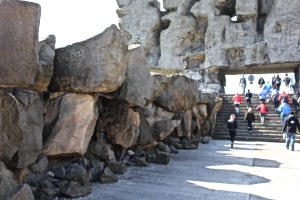
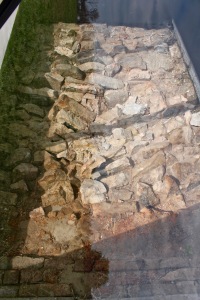
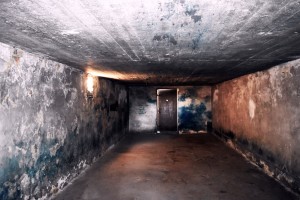
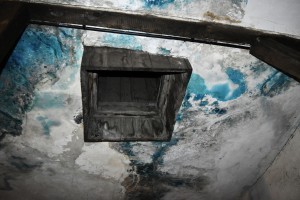
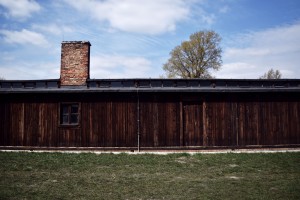

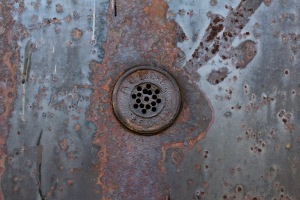
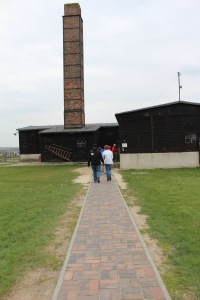
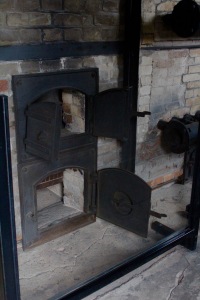

During our journey, we’ll share a few highlight photos per day in our daily blog, yet to see ALL of our photos (many per day, including more detail of this preserved camp), go to our shared album here. https://www.icloud.com/sharedalbum/#B0SJqstnBJ10BQS
